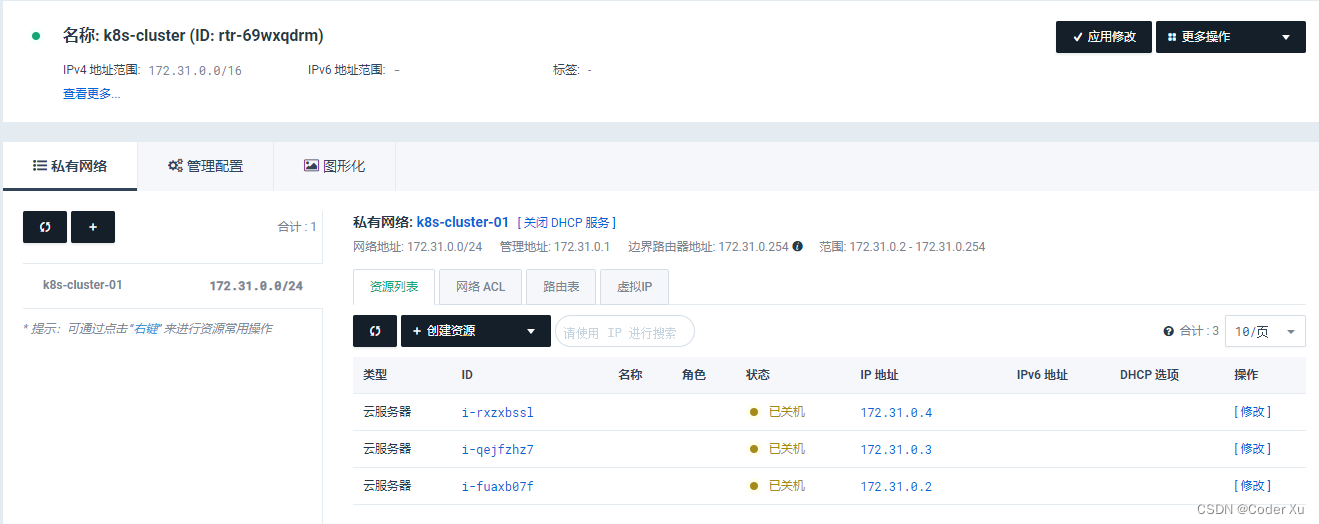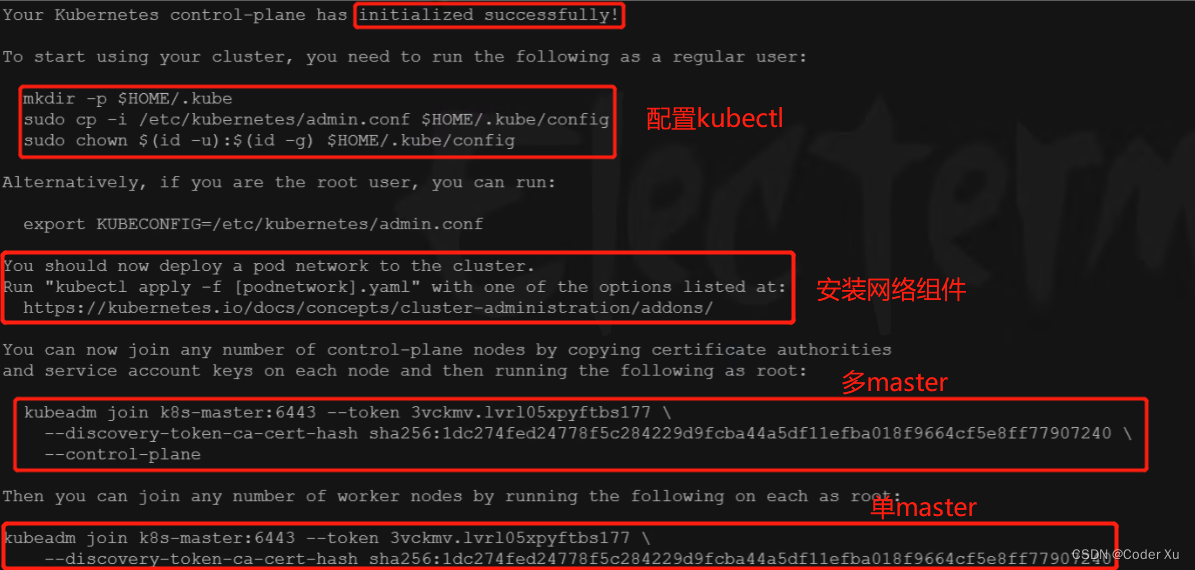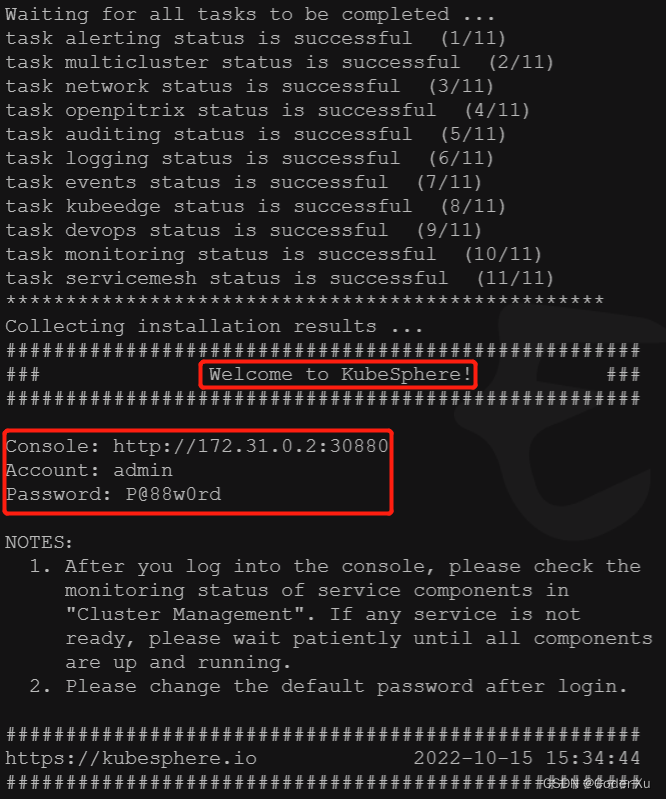您现在的位置是:主页 > news > 选择扬中网站建设/移动建站模板
选择扬中网站建设/移动建站模板
![]() admin2025/5/3 23:54:25【news】
admin2025/5/3 23:54:25【news】
简介选择扬中网站建设,移动建站模板,wordpress情侣,长春网站建设电话咨询文章目录前言1、安装Docker2、安装Kubernetes2.1、基础环境2.2、安装kubelet、kubeadm、kubectl2.3、初始化Master节点2.4、安装Colico网络组件2.5、加入Worker节点3、安装KubeSphere前置环境3.1、安装NFS3.2、配置默认存储3.3、安装metrics-server4、安装KubeSphere4.1、下载核…
文章目录
- 前言
- 1、安装Docker
- 2、安装Kubernetes
- 2.1、基础环境
- 2.2、安装kubelet、kubeadm、kubectl
- 2.3、初始化Master节点
- 2.4、安装Colico网络组件
- 2.5、加入Worker节点
- 3、安装KubeSphere前置环境
- 3.1、安装NFS
- 3.2、配置默认存储
- 3.3、安装metrics-server
- 4、安装KubeSphere
- 4.1、下载核心文件
- 4.2、修改cluster-configuration.yaml
- 4.3、安装核心文件
- 4.4、查看安装进度
前言
首先准备三台服务器(我选择的是青云CentOS7.9):一个主服务器配置为4核8G,两个从服务器配置为8核16G

三台服务器处于同一个VPC中:

并且公用一个安全组,安全组之间保证组内互信:

1、安装Docker
每台服务器都需要执行:
# 删除Docker
yum remove docker*# 安装yum工具
yum install -y yum-utils# 配置docker的yum源
yum-config-manager \
--add-repo \
http://mirrors.aliyun.com/docker-ce/linux/centos/docker-ce.repo# 安装Docker
yum install -y docker-ce-20.10.7 docker-ce-cli-20.10.7 containerd.io-1.4.6# 将Docker设置为开机启动
systemctl enable docker --now# Docker加速配置
mkdir -p /etc/docker
tee /etc/docker/daemon.json <<-'EOF'
{"registry-mirrors": ["https://82m9ar63.mirror.aliyuncs.com"],"exec-opts": ["native.cgroupdriver=systemd"],"log-driver": "json-file","log-opts": {"max-size": "100m"},"storage-driver": "overlay2"
}
EOFsystemctl daemon-reload
systemctl restart docker
2、安装Kubernetes
2.1、基础环境
每台服务器都需要执行:
# 为每台服务器设置hostname
hostnamectl set-hostname k8s-master
hostnamectl set-hostname node1
hostnamectl set-hostname node2# 将 SELinux 设置为 permissive 模式(相当于将其禁用)
setenforce 0
sed -i 's/^SELINUX=enforcing$/SELINUX=permissive/' /etc/selinux/config# 关闭swap
swapoff -a
sed -ri 's/.*swap.*/#&/' /etc/fstab#允许 iptables 检查桥接流量
cat <<EOF | sudo tee /etc/modules-load.d/k8s.conf
br_netfilter
EOFcat <<EOF | sudo tee /etc/sysctl.d/k8s.conf
net.bridge.bridge-nf-call-ip6tables = 1
net.bridge.bridge-nf-call-iptables = 1
EOFsysctl --system
2.2、安装kubelet、kubeadm、kubectl
每台服务器都需要执行:
# 配置k8s的yum源
cat <<EOF | sudo tee /etc/yum.repos.d/kubernetes.repo
[kubernetes]
name=Kubernetes
baseurl=http://mirrors.aliyun.com/kubernetes/yum/repos/kubernetes-el7-x86_64
enabled=1
gpgcheck=0
repo_gpgcheck=0
gpgkey=http://mirrors.aliyun.com/kubernetes/yum/doc/yum-key.gpghttp://mirrors.aliyun.com/kubernetes/yum/doc/rpm-package-key.gpg
EOF# 安装kubelet、kubeadm、kubectl
yum install -y kubelet-1.20.9 kubeadm-1.20.9 kubectl-1.20.9# 启动kubelet
systemctl enable --now kubelet# 配置master域名(内网ip通过"ip a"命令查看)
echo "172.31.0.2 k8s-master" >> /etc/hosts# 测试每台机器是否能ping通master的ip
ping k8s-master
2.3、初始化Master节点
Master节点执行:
# 初始化Master(注意ip地址和主机hostname)
kubeadm init \
--apiserver-advertise-address=172.31.0.2 \
--control-plane-endpoint=k8s-master \
--image-repository registry.cn-hangzhou.aliyuncs.com/lfy_k8s_images \
--kubernetes-version v1.20.9 \
--service-cidr=10.96.0.0/16 \
--pod-network-cidr=192.168.0.0/16
Master节点初始化成功后,返回信息非常重要,信息如下:

Master节点执行:
# 根据初始化后得到需要执行的命令
mkdir -p $HOME/.kube
sudo cp -i /etc/kubernetes/admin.conf $HOME/.kube/config
sudo chown $(id -u):$(id -g) $HOME/.kube/config
2.4、安装Colico网络组件
Master节点执行:
# 下载colico.yaml
curl https://docs.projectcalico.org/v3.20/manifests/calico.yaml -O# 应用配置文件
kubectl apply -f calico.yaml
2.5、加入Worker节点
Worker节点执行:
# 根据初始化后得到需要执行join命令(单master)
kubeadm join k8s-master:6443 --token du2751.mt5rvcgkgo8n806v \--discovery-token-ca-cert-hash sha256:0c4e306dbe725c5363ad272954f3d7bdc00fcb0c6c249338b9ab8f9e6f7c3b02
经过上述操作,我们已经把K8S集群搭建完成了!
注意:之所以没有安装dashboard,因为我们会使用KubeSphere取代dashboard
3、安装KubeSphere前置环境
3.1、安装NFS
每台服务器都执行:
# 安装NFS工具
yum install -y nfs-utils
Master服务器执行:
# 暴露挂载配置
echo "/nfs/data/ *(insecure,rw,sync,no_root_squash)" > /etc/exports# 创建挂载目录
mkdir -p /nfs/data# 应用rpcbind
systemctl enable rpcbind# 应用NFS服务器
systemctl enable nfs-server# 启动rpcbind
systemctl start rpcbind# 启动NFS服务器
systemctl start nfs-server# 激活上述配置
exportfs -r# 检查NFS
exportfs
Worker服务器执行:
# 使用Master的内网ip
showmount -e 172.31.0.2
mkdir -p /nfs/data
mount -t nfs 172.31.0.2:/nfs/data /nfs/data
3.2、配置默认存储
用于实现PV的动态供应,Master执行:
# 创建配置文件
vi sc.yaml
粘贴内容如下(记得切换ip):
## 创建了一个存储类
apiVersion: storage.k8s.io/v1
kind: StorageClass
metadata:name: nfs-storageannotations:storageclass.kubernetes.io/is-default-class: "true"
provisioner: k8s-sigs.io/nfs-subdir-external-provisioner
parameters:archiveOnDelete: "true" ## 删除pv的时候,pv的内容是否要备份---
apiVersion: apps/v1
kind: Deployment
metadata:name: nfs-client-provisionerlabels:app: nfs-client-provisioner# replace with namespace where provisioner is deployednamespace: default
spec:replicas: 1strategy:type: Recreateselector:matchLabels:app: nfs-client-provisionertemplate:metadata:labels:app: nfs-client-provisionerspec:serviceAccountName: nfs-client-provisionercontainers:- name: nfs-client-provisionerimage: registry.cn-hangzhou.aliyuncs.com/lfy_k8s_images/nfs-subdir-external-provisioner:v4.0.2# resources:# limits:# cpu: 10m# requests:# cpu: 10mvolumeMounts:- name: nfs-client-rootmountPath: /persistentvolumesenv:- name: PROVISIONER_NAMEvalue: k8s-sigs.io/nfs-subdir-external-provisioner- name: NFS_SERVERvalue: 172.31.0.2 ## 指定自己nfs服务器地址- name: NFS_PATH value: /nfs/data ## nfs服务器共享的目录volumes:- name: nfs-client-rootnfs:server: 172.31.0.2path: /nfs/data
---
apiVersion: v1
kind: ServiceAccount
metadata:name: nfs-client-provisioner# replace with namespace where provisioner is deployednamespace: default
---
kind: ClusterRole
apiVersion: rbac.authorization.k8s.io/v1
metadata:name: nfs-client-provisioner-runner
rules:- apiGroups: [""]resources: ["nodes"]verbs: ["get", "list", "watch"]- apiGroups: [""]resources: ["persistentvolumes"]verbs: ["get", "list", "watch", "create", "delete"]- apiGroups: [""]resources: ["persistentvolumeclaims"]verbs: ["get", "list", "watch", "update"]- apiGroups: ["storage.k8s.io"]resources: ["storageclasses"]verbs: ["get", "list", "watch"]- apiGroups: [""]resources: ["events"]verbs: ["create", "update", "patch"]
---
kind: ClusterRoleBinding
apiVersion: rbac.authorization.k8s.io/v1
metadata:name: run-nfs-client-provisioner
subjects:- kind: ServiceAccountname: nfs-client-provisioner# replace with namespace where provisioner is deployednamespace: default
roleRef:kind: ClusterRolename: nfs-client-provisioner-runnerapiGroup: rbac.authorization.k8s.io
---
kind: Role
apiVersion: rbac.authorization.k8s.io/v1
metadata:name: leader-locking-nfs-client-provisioner# replace with namespace where provisioner is deployednamespace: default
rules:- apiGroups: [""]resources: ["endpoints"]verbs: ["get", "list", "watch", "create", "update", "patch"]
---
kind: RoleBinding
apiVersion: rbac.authorization.k8s.io/v1
metadata:name: leader-locking-nfs-client-provisioner# replace with namespace where provisioner is deployednamespace: default
subjects:- kind: ServiceAccountname: nfs-client-provisioner# replace with namespace where provisioner is deployednamespace: default
roleRef:kind: Rolename: leader-locking-nfs-client-provisionerapiGroup: rbac.authorization.k8s.io
# 应用配置文件
kubectl apply -f sc.yaml
3.3、安装metrics-server
用于完成集群指标监控的组件,主节点执行:
# 创建文件
vi metrics.yaml
粘贴内容如下:
apiVersion: v1
kind: ServiceAccount
metadata:labels:k8s-app: metrics-servername: metrics-servernamespace: kube-system
---
apiVersion: rbac.authorization.k8s.io/v1
kind: ClusterRole
metadata:labels:k8s-app: metrics-serverrbac.authorization.k8s.io/aggregate-to-admin: "true"rbac.authorization.k8s.io/aggregate-to-edit: "true"rbac.authorization.k8s.io/aggregate-to-view: "true"name: system:aggregated-metrics-reader
rules:
- apiGroups:- metrics.k8s.ioresources:- pods- nodesverbs:- get- list- watch
---
apiVersion: rbac.authorization.k8s.io/v1
kind: ClusterRole
metadata:labels:k8s-app: metrics-servername: system:metrics-server
rules:
- apiGroups:- ""resources:- pods- nodes- nodes/stats- namespaces- configmapsverbs:- get- list- watch
---
apiVersion: rbac.authorization.k8s.io/v1
kind: RoleBinding
metadata:labels:k8s-app: metrics-servername: metrics-server-auth-readernamespace: kube-system
roleRef:apiGroup: rbac.authorization.k8s.iokind: Rolename: extension-apiserver-authentication-reader
subjects:
- kind: ServiceAccountname: metrics-servernamespace: kube-system
---
apiVersion: rbac.authorization.k8s.io/v1
kind: ClusterRoleBinding
metadata:labels:k8s-app: metrics-servername: metrics-server:system:auth-delegator
roleRef:apiGroup: rbac.authorization.k8s.iokind: ClusterRolename: system:auth-delegator
subjects:
- kind: ServiceAccountname: metrics-servernamespace: kube-system
---
apiVersion: rbac.authorization.k8s.io/v1
kind: ClusterRoleBinding
metadata:labels:k8s-app: metrics-servername: system:metrics-server
roleRef:apiGroup: rbac.authorization.k8s.iokind: ClusterRolename: system:metrics-server
subjects:
- kind: ServiceAccountname: metrics-servernamespace: kube-system
---
apiVersion: v1
kind: Service
metadata:labels:k8s-app: metrics-servername: metrics-servernamespace: kube-system
spec:ports:- name: httpsport: 443protocol: TCPtargetPort: httpsselector:k8s-app: metrics-server
---
apiVersion: apps/v1
kind: Deployment
metadata:labels:k8s-app: metrics-servername: metrics-servernamespace: kube-system
spec:selector:matchLabels:k8s-app: metrics-serverstrategy:rollingUpdate:maxUnavailable: 0template:metadata:labels:k8s-app: metrics-serverspec:containers:- args:- --cert-dir=/tmp- --kubelet-insecure-tls- --secure-port=4443- --kubelet-preferred-address-types=InternalIP,ExternalIP,Hostname- --kubelet-use-node-status-portimage: registry.cn-hangzhou.aliyuncs.com/lfy_k8s_images/metrics-server:v0.4.3imagePullPolicy: IfNotPresentlivenessProbe:failureThreshold: 3httpGet:path: /livezport: httpsscheme: HTTPSperiodSeconds: 10name: metrics-serverports:- containerPort: 4443name: httpsprotocol: TCPreadinessProbe:failureThreshold: 3httpGet:path: /readyzport: httpsscheme: HTTPSperiodSeconds: 10securityContext:readOnlyRootFilesystem: truerunAsNonRoot: truerunAsUser: 1000volumeMounts:- mountPath: /tmpname: tmp-dirnodeSelector:kubernetes.io/os: linuxpriorityClassName: system-cluster-criticalserviceAccountName: metrics-servervolumes:- emptyDir: {}name: tmp-dir
---
apiVersion: apiregistration.k8s.io/v1
kind: APIService
metadata:labels:k8s-app: metrics-servername: v1beta1.metrics.k8s.io
spec:group: metrics.k8s.iogroupPriorityMinimum: 100insecureSkipTLSVerify: trueservice:name: metrics-servernamespace: kube-systemversion: v1beta1versionPriority: 100
应用配置文件:
kubectl apply -f metrics.yaml
4、安装KubeSphere
4.1、下载核心文件
主节点执行:
# 安装wget、vim工具
yum install -y wget
yum install -y vim# 下载kubesphere安装器
wget https://github.com/kubesphere/ks-installer/releases/download/v3.1.1/kubesphere-installer.yaml# 下载集群配置文件
wget https://github.com/kubesphere/ks-installer/releases/download/v3.1.1/cluster-configuration.yaml
4.2、修改cluster-configuration.yaml
修改cluster-configuration.yaml如下:
---
apiVersion: installer.kubesphere.io/v1alpha1
kind: ClusterConfiguration
metadata:name: ks-installernamespace: kubesphere-systemlabels:version: v3.1.1
spec:persistence:storageClass: "" # If there is no default StorageClass in your cluster, you need to specify an existing StorageClass here.authentication:jwtSecret: "" # Keep the jwtSecret consistent with the Host Cluster. Retrieve the jwtSecret by executing "kubectl -n kubesphere-system get cm kubesphere-config -o yaml | grep -v "apiVersion" | grep jwtSecret" on the Host Cluster.local_registry: "" # Add your private registry address if it is needed.etcd:monitoring: true # Enable or disable etcd monitoring dashboard installation. You have to create a Secret for etcd before you enable it.endpointIps: 172.31.0.2 # etcd cluster EndpointIps. It can be a bunch of IPs here.port: 2379 # etcd port.tlsEnable: truecommon:redis:enabled: trueopenldap:enabled: trueminioVolumeSize: 20Gi # Minio PVC size.openldapVolumeSize: 2Gi # openldap PVC size.redisVolumSize: 2Gi # Redis PVC size.monitoring:# type: external # Whether to specify the external prometheus stack, and need to modify the endpoint at the next line.endpoint: http://prometheus-operated.kubesphere-monitoring-system.svc:9090 # Prometheus endpoint to get metrics data.es: # Storage backend for logging, events and auditing.# elasticsearchMasterReplicas: 1 # The total number of master nodes. Even numbers are not allowed.# elasticsearchDataReplicas: 1 # The total number of data nodes.elasticsearchMasterVolumeSize: 4Gi # The volume size of Elasticsearch master nodes.elasticsearchDataVolumeSize: 20Gi # The volume size of Elasticsearch data nodes.logMaxAge: 7 # Log retention time in built-in Elasticsearch. It is 7 days by default.elkPrefix: logstash # The string making up index names. The index name will be formatted as ks-<elk_prefix>-log.basicAuth:enabled: falseusername: ""password: ""externalElasticsearchUrl: ""externalElasticsearchPort: ""console:enableMultiLogin: true # Enable or disable simultaneous logins. It allows different users to log in with the same account at the same time.port: 30880alerting: # (CPU: 0.1 Core, Memory: 100 MiB) It enables users to customize alerting policies to send messages to receivers in time with different time intervals and alerting levels to choose from.enabled: true # Enable or disable the KubeSphere Alerting System.# thanosruler:# replicas: 1# resources: {}auditing: # Provide a security-relevant chronological set of records,recording the sequence of activities happening on the platform, initiated by different tenants.enabled: true # Enable or disable the KubeSphere Auditing Log System. devops: # (CPU: 0.47 Core, Memory: 8.6 G) Provide an out-of-the-box CI/CD system based on Jenkins, and automated workflow tools including Source-to-Image & Binary-to-Image.enabled: true # Enable or disable the KubeSphere DevOps System.jenkinsMemoryLim: 2Gi # Jenkins memory limit.jenkinsMemoryReq: 1500Mi # Jenkins memory request.jenkinsVolumeSize: 8Gi # Jenkins volume size.jenkinsJavaOpts_Xms: 512m # The following three fields are JVM parameters.jenkinsJavaOpts_Xmx: 512mjenkinsJavaOpts_MaxRAM: 2gevents: # Provide a graphical web console for Kubernetes Events exporting, filtering and alerting in multi-tenant Kubernetes clusters.enabled: true # Enable or disable the KubeSphere Events System.ruler:enabled: truereplicas: 2logging: # (CPU: 57 m, Memory: 2.76 G) Flexible logging functions are provided for log query, collection and management in a unified console. Additional log collectors can be added, such as Elasticsearch, Kafka and Fluentd.enabled: true # Enable or disable the KubeSphere Logging System.logsidecar:enabled: truereplicas: 2metrics_server: # (CPU: 56 m, Memory: 44.35 MiB) It enables HPA (Horizontal Pod Autoscaler).enabled: false # Enable or disable metrics-server.monitoring:storageClass: "" # If there is an independent StorageClass you need for Prometheus, you can specify it here. The default StorageClass is used by default.# prometheusReplicas: 1 # Prometheus replicas are responsible for monitoring different segments of data source and providing high availability.prometheusMemoryRequest: 400Mi # Prometheus request memory.prometheusVolumeSize: 20Gi # Prometheus PVC size.# alertmanagerReplicas: 1 # AlertManager Replicas.multicluster:clusterRole: none # host | member | none # You can install a solo cluster, or specify it as the Host or Member Cluster.network:networkpolicy: # Network policies allow network isolation within the same cluster, which means firewalls can be set up between certain instances (Pods).# Make sure that the CNI network plugin used by the cluster supports NetworkPolicy. There are a number of CNI network plugins that support NetworkPolicy, including Calico, Cilium, Kube-router, Romana and Weave Net.enabled: true # Enable or disable network policies.ippool: # Use Pod IP Pools to manage the Pod network address space. Pods to be created can be assigned IP addresses from a Pod IP Pool.type: calico # Specify "calico" for this field if Calico is used as your CNI plugin. "none" means that Pod IP Pools are disabled.topology: # Use Service Topology to view Service-to-Service communication based on Weave Scope.type: none # Specify "weave-scope" for this field to enable Service Topology. "none" means that Service Topology is disabled.openpitrix: # An App Store that is accessible to all platform tenants. You can use it to manage apps across their entire lifecycle.store:enabled: true # Enable or disable the KubeSphere App Store.servicemesh: # (0.3 Core, 300 MiB) Provide fine-grained traffic management, observability and tracing, and visualized traffic topology.enabled: true # Base component (pilot). Enable or disable KubeSphere Service Mesh (Istio-based).kubeedge: # Add edge nodes to your cluster and deploy workloads on edge nodes.enabled: true # Enable or disable KubeEdge.cloudCore:nodeSelector: {"node-role.kubernetes.io/worker": ""}tolerations: []cloudhubPort: "10000"cloudhubQuicPort: "10001"cloudhubHttpsPort: "10002"cloudstreamPort: "10003"tunnelPort: "10004"cloudHub:advertiseAddress: # At least a public IP address or an IP address which can be accessed by edge nodes must be provided.- "" # Note that once KubeEdge is enabled, CloudCore will malfunction if the address is not provided.nodeLimit: "100"service:cloudhubNodePort: "30000"cloudhubQuicNodePort: "30001"cloudhubHttpsNodePort: "30002"cloudstreamNodePort: "30003"tunnelNodePort: "30004"edgeWatcher:nodeSelector: {"node-role.kubernetes.io/worker": ""}tolerations: []edgeWatcherAgent:nodeSelector: {"node-role.kubernetes.io/worker": ""}tolerations: []
4.3、安装核心文件
# 安装核心文件
kubectl apply -f kubesphere-installer.yaml
kubectl apply -f cluster-configuration.yaml
4.4、查看安装进度
4.3的安装流程会比较久(大概20分钟),使用下述命令查看KubeSphere安装进度(主节点执行):
# 查看KubeSphere安装进度
kubectl logs -n kubesphere-system $(kubectl get pod -n kubesphere-system -l app=ks-install -o jsonpath='{.items[0].metadata.name}') -f
最终控制台会打印出登录KubeSphere的账号密码:

还需要解决etcd监控证书找不到问题:
kubectl -n kubesphere-monitoring-system create secret generic kube-etcd-client-certs --from-file=etcd-client-ca.crt=/etc/kubernetes/pki/etcd/ca.crt --from-file=etcd-client.crt=/etc/kubernetes/pki/apiserver-etcd-client.crt --from-file=etcd-client.key=/etc/kubernetes/pki/apiserver-etcd-client.key
等待所有pod处于Running,即可登录KubeSphere
Console: 公网ip:30880
Account: admin
Password: P@88w0rd
![[外链图片转存失败,源站可能有防盗链机制,建议将图片保存下来直接上传(img-QVW909rI-1665821176090)(C:\Users\lzkj\AppData\Roaming\Typora\typora-user-images\image-20221015155613212.png)]](https://img-blog.csdnimg.cn/b8b8be0796554c9b9e42b39cde9c9748.png)








